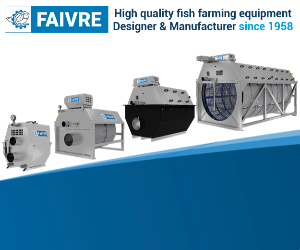| |
| |
 |
 |
| |
 |
|
@{mv_date_MMM d, yyyy}@ |
|
| |
 Kristoffer Lund is the new group chief executive officer at Billund Aquaculture in Denmark as of April 2. Lund replaces Billund founder, Christian Sørensen, who is stepping down as CEO to a more advisory role, the company said.
» Read More...
Kristoffer Lund is the new group chief executive officer at Billund Aquaculture in Denmark as of April 2. Lund replaces Billund founder, Christian Sørensen, who is stepping down as CEO to a more advisory role, the company said.
» Read More...
Nordic Aqua Partners AS reported the successful completion of its first Altantic salmon harvest at its recirculating aquaculture facility in Gaotang, China. The harvest marks the company's transition to full operational status.
» Read More...
|
| |

|

|
| |
|
| |

- 4 Designs and 6 sizes to adapt your configuration.
- High-quality stainless-steel construction: AISI 304L, AISI 316L, DUPLEX 2205.
- Up to 3240 m3/h filtration capacity.
- Large choice of filter mesh, from 15 to 500 microns (nylon or stainless steel).
- Simple, reliable and robust Belt Drive & Support System for very low maintenance.
- Patented filter plates Spiderplate ®.
» Learn more…
|
| |
|
| |
 Controlling dissolved oxygen using pure oxygen is critical in intensive RAS systems. Published literature indicates that oxygen use can be three to five per cent of overall production costs. As with feed or electricity inputs, it is important to manage this resource efficiently. Yet, oxygen is often managed by setting gas use at fixed levels and then adjusting gas flow based on operator-observed dissolved oxygen (DO) concentration levels and know-how.
» Read more
Controlling dissolved oxygen using pure oxygen is critical in intensive RAS systems. Published literature indicates that oxygen use can be three to five per cent of overall production costs. As with feed or electricity inputs, it is important to manage this resource efficiently. Yet, oxygen is often managed by setting gas use at fixed levels and then adjusting gas flow based on operator-observed dissolved oxygen (DO) concentration levels and know-how.
» Read more |
| |
 Research scientist, John Davidson, and The Freshwater Institute team are conducting some of the leading research around understanding off-flavour in recirculating aquaculture systems. In this episode, he shares his latest findings with co-hosts Jean Ko Din and Justin Henry.
» Read More...
Research scientist, John Davidson, and The Freshwater Institute team are conducting some of the leading research around understanding off-flavour in recirculating aquaculture systems. In this episode, he shares his latest findings with co-hosts Jean Ko Din and Justin Henry.
» Read More... |
| |
| |

|

|
| |
|
| |
 Many RAS-grown fish are marketed as local, sustainable options. While these characteristics are commonly pointed out as differentiators, how does the eating experience compare?
» Read More...
Many RAS-grown fish are marketed as local, sustainable options. While these characteristics are commonly pointed out as differentiators, how does the eating experience compare?
» Read More...
The RAS workplace can be fast-paced and physically demanding. There will always be pressure to meet production goals in an industry with tight profit margins. Over time, this can lead to feelings that employees lack autonomy and control over their day, which can lead to burnout.
» Read More...
|
| |
|
| |

|
| |
|
| |

|
| |
| |













